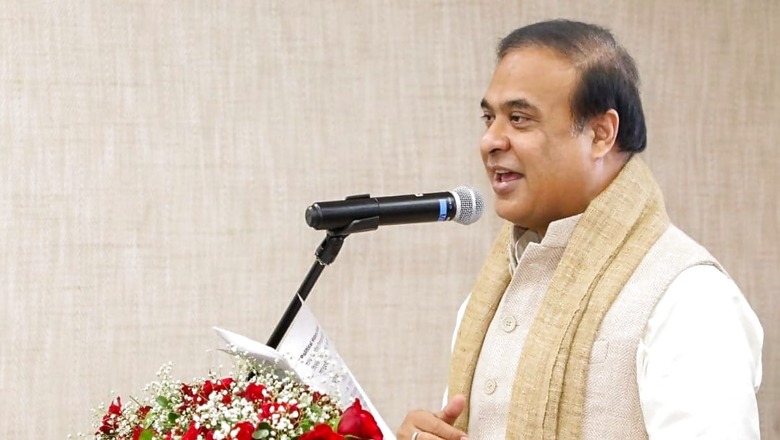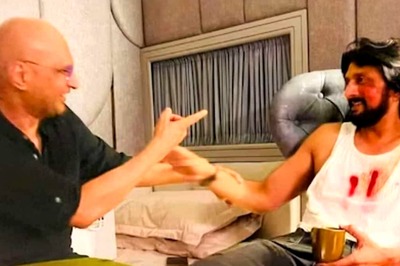
views
As announced by Chief Minister, Himanta Biswa Sarma, on February 23, 2024, the Muslim Marriage and Divorce Registration Act, 1935 stands repealed in Assam. Inarguably, the Assam Cabinet’s decision is revolutionarily progressive and praiseworthy, in letter and spirit. In a bold assertion, the Assam CM in the state assembly on February 26, 2024, announced that he will not allow child marriages to happen in the state until he is alive. His assertion is embedded in the grim social realities of under-age women’s abuse under the system of marriage, thus leading to the worst possible crimes and discrimination against women and children.
It is a significant step towards concretisation of the prohibition of child marriage in the state, as the Muslim Marriage and Divorce Registration Act, 1935, allows marriages to be registered even if both parties have not attained the legal age of 18 and 21, respectively. The provision states in the Muslim Marriage Act that marriage is possible if the bride has attained puberty and the marriage union is consensual. Thus, the Muslim Marriage Act clearly legalises such underage marriages. The usage of such personal laws promoting underage marriages is unsound as per modern legal codes, scientifically deleterious and socio-economically dangerous, leading to inter-generational gender deprivation.
The Himanta Biswa Sarma dispensation has been quite firm on its stance on the prohibition of child marriage in the politically most courageous way to create a more inclusive ecosystem for the Muslim youth, across the gender. And child marriages are perpetuated mainly by underdevelopment, poverty, lack of education and narrowed social choices.
Earlier, in March 2023, the Himanta Biswa Sarma dispensation decided to book men who married girls aged below 14 under the Protection of Children from Sexual Offences Act, 2012 (POCSO) and the Prohibition of Child Marriage Act, 2006 (PCMA). Sarma, briefing the Cabinet decision, stated that men marrying girls below 14 years of age will be facing non-bailable charges, while those marrying girls between 14 and 16 years of age will be charged under bailable sections. If the groom is below 14 years of age, he will be sent to a reform house. Muslims constitute 34 per cent population of Assam as per the census of 2011 accounting for 1.06 crore out of the 3.12 crore population of the state. Underdevelopment of such a huge chunk of the population and non-contribution to the workforce will adversely affect the society and economy of the state.
Child Marriage: A Societal Scourge
Child marriages expose the underage bride to domestic violence, pregnancy and hampered economic prospects (as per the Law Commission of India reports). The need for legislative interventions in the form of the latest Assam Cabinet’s decision to repeal the Muslim Marriage Act is a sine qua non to improve the conditions of women in the country, particularly of such a vulnerable age group of the marginalised communities. As per a recent study, government interventions have resulted in an average benefit-cost ratio of 16.8 per cent and are projected to decrease the rate of marriages of girls aged 15–17 years to 7.5 percentage points by 2050 and by 2030, the proportion of girls completing school is estimated to increase by 13 per cent along with increased productivity of 16.4 per cent.
Statistical data would state that as many as 32 per cent of women in the age group of 20-24 years in Assam are married before 18, according to the National Family Health Survey-5 (2019-21). Also, 12 per cent of women in the 15-19 age group were either mothers or pregnant. The majority of child brides in the world, i.e. 223 million of them, or one-third of the total, live in India and at least 1.5 million underage girls get married annually in India. According to the National Family Health Survey (2019-21), underage marriage accounted for 23.3 per cent of the total marriages in India. In India, nearly 16 per cent of adolescent girls aged 15-19 are currently married. While the prevalence of girls getting married before 18 has declined from 47 per cent to 27 per cent between 2005-2006 and 2015-2016, it is still too high. The NCRB says in 2019, 523 cases were registered under the PCMA, 2006 while in 2018, 501 cases were lodged.
Noticeably, the Indian National Congress (INC) and All India United Democratic Front (AIUDF) both staged a protest and walkouts later, in the State Assembly, against the Assam Cabinet decision to repeal the archaic and medieval Muslim Marriage and Divorce Registration Act, 1935. This divides the progressive and conscientious vision of Himanta Biswa Sarma along with his grit and political courage to lead such reformatory legislation for the creation of a more inclusive society in the state, and the Congress modus operandi of catapulting Muslim sentiments towards obscurantism, disapproving social progress among the community. The Congress’ pro-Islamic fundamentalist stance can be seen in various misguided decisions of the party when it was in power, e.g. the Rajiv Gandhi government’s passing of the Muslim Women (Protection on Divorce) Act, 1986, overturning a progressive verdict of the Supreme Court in favour of the old, divorced Muslim woman Shah Bano, seeking maintenance from her ex-husband.
So, the attitude and the disposition of the Congress is that of being typically and categorically against engendering any progressive ideas among the Muslims, the largest minority of the nation. The INC has always been intersecting a disorderly intervention in religion vis-à-vis individual rights, liberal democracy vis-à-vis religious fundamentalism, and progress vis-à-vis obscurantism. And this disposition of the INC negates the Nehruvian secularism and scientific temperament envisioned by the leader, post-independence.
Muslim Marriage Act and Puberty and Decisional Autonomy
Unlike Hindu Marriage Law, Muslim marriage is a contract validated by the capacity of the parties to maintain, where ‘puberty’ stands as a capacity. However, to consider ‘puberty’ as a capacity is legally and morally inaccurate even under the Muslim Personal Law. Musawah is a Muslim women-led movement for gender equality within the religion. It explains candidly in a statement that Bulugh (puberty) and Rushd (intellectual capacity to handle property-related affairs) are two capacities needed for the marriage contract, only one capacity i.e. Bulugh is not a substantial standalone factor enough to make a marriage contract valid. Rushd is an imperative factor to be considered, as it will provide the bride to be independent and mature enough to make marital decisions, given its consequences on her educational and professional aspirations and economic worth. Thus, Rushd can be equated with ‘decisional autonomy’, declared to be fundamental by the Supreme Court to be inalienable in any such unions.
A child bride will be out of school and turn non-contributing to financial activities and become less productive, thus contributing to a low Labour Force Participation Rate (LFPR) for women. According to the Annual Periodic Labour Force Survey, LFPR registered for women is 25.1 per cent against 57.5 per cent for men in 2020-21. Of all the parameters listed by the ILO that affect the LFPR negatively, child marriage remains a major one, thus impacting the national economy, leading to an inter-generational cycle of poverty with unskilled girls and boys.
Consensual marriage is a misnomer for a minor who is incapable of naturally making decisions accurately with autonomy. India does not have close-in-age exemptions and the age of consent in India is currently set at 18. While the IPC earlier prescribed it to be 16, POCSO set the age at 18, creating a discrepancy. However, this discrepancy was removed, when the Criminal Law (Amendment) Act of 2013 increased the age of consent under Section 375 from 16 to 18. Therefore, any person under the age of 18 is legally incapable of giving their consent, and any sexual relations they enter into shall be unlawful. If an older person engages in sexual activity with an underage person, it shall be considered as statutory rape, even if the two are in a mutual, consenting relationship.
Families have no qualms about marrying their underage daughters to older men and underage female brides under family pressure are compelled to give their consent for such marriages. A recent study conducted by the National Law School of India University’s (NLSIU) Centre for Child and the Law showed that cases revolving around romantic relationships accounted for 21.58 per cent in Delhi, 21.21 per cent in Andhra Pradesh, 20.52 per cent in Maharashtra, 15.69 per cent in Assam, and 5.45 per cent in Karnataka, meaning rest of such marriages are all arranged by their families, which is a staggering number. Another recent study revealed that 24 per cent of all POCSO Act cases registered in 2016-2020 (3 states data) involved consensual relationships. However, to differentiate between forced unions and consensual unions again is problematic. Any eagerness to validate such underage marriages merely on the grounds of consent and religion will throw the floodgates open to allow forced and even abusive ‘arranged’ marriages of child brides to much older men to be protected on similar grounds.
The Delhi High Court showed similar eagerness in Fija v. State (NCT of Delhi) (involving the runaway marriage of a 15-year-old girl), allowing Muslim Personal Law to precede the PCMA but failing to even note the age of the groom. The accused, Javed, was 26 years old. This is a case where it can be stated that ‘what is legal is not always moral’. To avoid such situations, government interventions in the form of laws and legislations clearly prohibiting such underage unions, unless both the parties are physically and mentally in a mature stage to exercise ‘decisional autonomy’, is sine qua non.
Age, decisional autonomy and judicial deliberations
Decisional autonomy, which comes with age and economic independence, is recognised as a fundamental right in the Justice K S Puttaswamy v. Union of India, 2017 case. Even in the pre-Puttaswamy position, the Supreme Court in Independent Thought v. Union of India, 2013, which removed the ‘marital rape exception’ in the Indian Penal Code (IPC) for child brides, noted how child marriage violates bodily integrity and decisional autonomy.
Bodily integrity is relevant to the discussion on PCMA not only in theory (cases have recognised that sex constitutes an ‘important’ aspect of marriage) but also practically. Minors in forced “arranged” child marriages, lacking access to justice and therefore unable to file rape complaints or marriage annulments, may become inextricably trapped in a vicious cycle of sexual violence leading to debilitating health and mental conditions of the victims. Despite having Acts like the PCMA and the POCSO in place, 1.5 million child marriages are happening each year in India, with ab initio invalidation. The NCPCR has filed a petition in the Supreme Court against the Punjab and Haryana High Court’s 2022 decision which upheld the marriage of a man with a minor girl. The plea said there is an increased belief among law enforcement and judicial circles that the POCSO Act is being misused and that the majority of cases under it result from consensual relationships between teenagers’ elopement, which is far from reality. It also claimed certain NGOs adopted flawed methodologies to present a wrong picture that 60-70 per cent of cases fall under the consensual relationship category. Such a claim is factually incorrect, misleading, and prejudicial to the interests of children, a colossal failure of the Indian criminal justice system.
The petition cited NCRB data which showed that from 2019 to 2021, there were a total of 1,50,061 victims of POCSO, of which, approximately 44,104 victims fall within the age bracket of 16 to 18 years. Therefore, the data corroborates that only 29.39 per cent of victims fall in the age bracket of 16-18 years and around 70 per cent of the victims are under the age of 16. It further contended that the POCSO and the Prohibition of Child Marriage Act are secular in nature and should apply to all sections of society, leaving no exceptions on the grounds of personal laws. Appearing for NCPCR, Solicitor General Tushar Mehta submitted that girls as young as 14 and 15 are being married and no personal law and custom be pleaded in the face of statutes such as POCSO, PCMA and the Indian Penal Code, which make such marriages an offence.
The Supreme Court, in December 2022, had already asked the government to respond to a separate petition filed by the National Commission for Women (NCW) to make the minimum age of marriage for Muslim women on par with persons belonging to other faiths, thus seeking through its petition the enforcement of the fundamental rights of minor Muslim women, who had contracted marriage before attaining the age of majority, whether consensually or otherwise. NCW, like the NCPCR, had raised the question of whether personal law could override statutory provisions of POCSO and the PCMA and argued in its petition that the practice of marrying below the age of 18 would expose Muslim women to abuse and harassment which is arbitrary and discriminatory in nature.
Child marriages and the far-reaching adverse impact on the individual, society and economy
International organisations like UNICEF and UNFPA have a commitment to stand firmly to eradicate this social evil. UNFPA promotes policies, programmes and legislation designed to end child marriage. The Sustainable Development Goals (SDGs) had included early marriage in target 5.3, aiming to eliminate it by 2030. Child marriage in India has grave implications for population control as adolescent brides are likely to have a high fertility rate, thus impacting a rise in TFR (Total Fertility Rate).
Child marriage negatively influences children’s rights to education, mental growth and development, health and protection which are fundamental rights and fall under the scope of Article 21 of the Indian Constitution which is a basic structure of the Constitution, making it inviolable under any circumstance.
A child bride is more susceptible to domestic violence and becomes infected with sexual diseases and HIV/AIDS. Child marriage is the main driving factor that negatively impacts the health, medical well-being, and nutritional status of the mother and the child, both in the ante-natal and post-natal way. It also adversely affects key parameters such as Infant Mortality Rate (IMR), Maternal Mortality Rate (MMR), Total Fertility Rate (TFR), Sex Ratio at Birth (SRB) and Child Sex Ratio (CSR). The goal to reduce MMR particularly is in tune with SDG 3, which aims by 2030, to reduce the global MMR to less than 70 per 100,000 live births.
Children account for 40 per cent of India’s total population. Collective societal and governmental contribution to the achievement of specific results in relation to the child population, in the form of short-term (increasing access to education, reducing anaemia), medium-term (ending child marriage) and long-term (eliminating gender-based sex selection and reaching gender equality). A continuous attempt by the government to improve the grassroots levels of execution mechanisms, of the various policy measures, advocacy initiatives coupled with Acts like the Juvenile Justice Act, 2015, POCSO Act, the PCMA and direct government initiatives to criminalise child marriage, like the Assam Cabinet’s decision to repeal the Muslim Marriage Act, will create a robust safety net to aid implement India’s dedicated mission of building a nurtured, safe and sustainable ecosystem for the children, particularly belonging to the marginalised strata.
The author is a senior faculty in the Department of History, ARSD College, University of Delhi. Views expressed in the above piece are personal and solely that of the author. They do not necessarily reflect News18’s views.




















Comments
0 comment